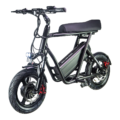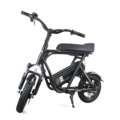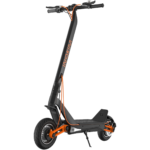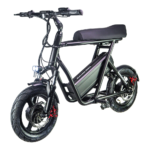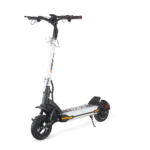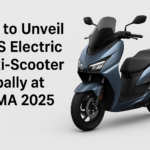- Home
- Scooters
- Electric Scooters
- EMOVE Roadster
EMOVE Roadster
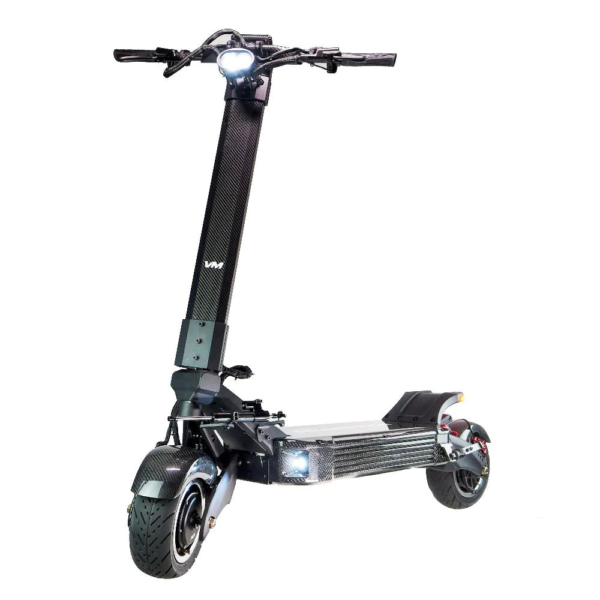

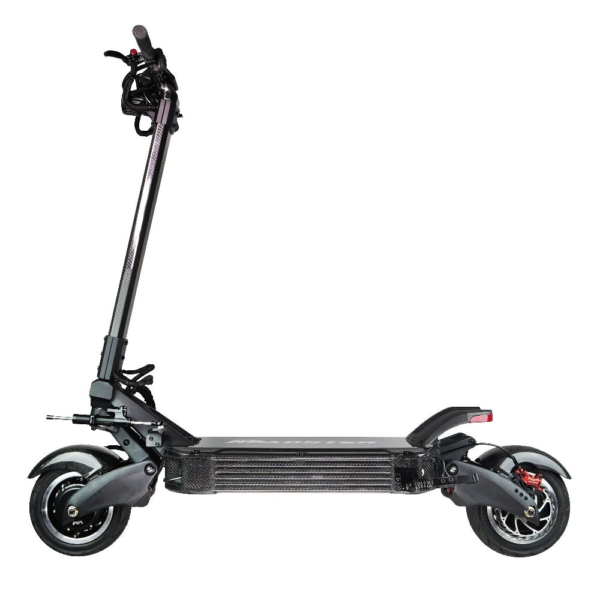
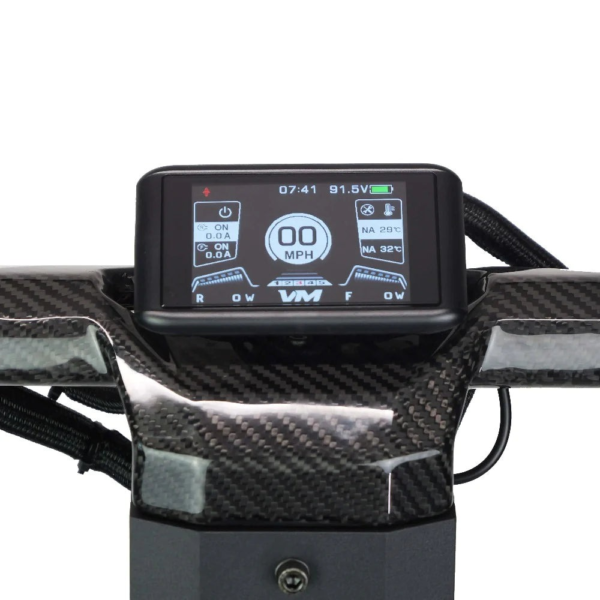
- Battery Range: 74 miles (119 km)
- Top Speed: 80 mph (129 km/h)
- Motor Power: 1000 W
- Weight Capacity: 500 lb (227.0 kg)
- Charging Time: ~5.7 h
- Scooter Weight: 143.0 lb (64.9 kg)
PROS
- Carbon fiber frame (T300) for high rigidity
- Magura MT5 hydraulic discs
- 11″ × 3.5″ tubeless street tires with sealant
- Dual adjustable hydraulic suspension
- Bright headlight + integrated turn signals
- IPX5 water resistance
CONS
- Non-folding, large footprint
- Very heavy to lift
- Premium price
- Performance demands experienced riders
Key Takeaways
- The EMOVE Roadster is a carbon-fiber hyper scooter designed for speed and stability, featuring dual motors and a robust frame.
- It offers a top speed of up to 80 mph and a range of 74 miles, making it ideal for experienced riders on long routes.
- The scooter includes features like adjustable hydraulic suspension, large hydraulic brakes, and a high-capacity battery for improved performance.
- With its non-folding design and heavy weight, the EMOVE Roadster suits riders prioritizing stability over portability.
- Overall, it provides a premium ride experience, focusing on high-speed control and durability, but may not be ideal for commuting in tight spaces.
Table of contents
- What Is the EMOVE Roadster?
- How the EMOVE Roadster Works
- Key Specifications
- Design & Build Quality
- Performance Fundamentals
- Battery, Range & Efficiency
- Ride Quality & Comfort
- Braking & Safety Features
- Portability & Daily Usability
- Maintenance & Care
- Weather & Seasonal Considerations
- EMOVE Roadster vs Alternatives
- Who the EMOVE Roadster Is (and Isn’t) For
- FAQs
- Glossary
The EMOVE Roadster is a carbon-fiber hyper scooter built for speed, stability, and control. It targets riders who want real road pace in a scooter form factor. So if you like strong pull, steady high-speed manners, and premium parts, this one belongs on your shortlist. We cover the specifications, ride feel, and care in plain terms.
It is not small or foldable. Instead, the EMOVE Roadster trades convenience for a stiff, bolted stem and a solid frame. So it suits riders who value stability more than carry weight. If that sounds right, keep reading. If you want a seated mini e-moto feel instead, see the EMOVE RoadRunner Pro. Or if you need long range in a folding frame, the EMOVE Cruiser V2 fits better.
What Is the EMOVE Roadster?
The EMOVE Roadster is a non-folding, dual-motor performance scooter with a carbon fiber body, Magura hydraulic brakes, adjustable hydraulic suspension, and a big 84 V 40 Ah battery built from Samsung 50S 21700 cells. It rolls on 11 × 3.5 in tubeless pneumatic tires (90/60-6.5) and uses dual 80 A sine-wave controllers. So power delivery comes on smooth, and the chassis stays calm when you push it.
You get a 3.5 in TFT display, a thumb throttle, and a built-in steering damper. The deck acts as a heat sink to shed controller and pack heat under load. And the lighting is complete: high-mounted headlight, deck lights front and rear, a taillight with turn signals, and brake lights. IPX5 water resistance adds day-to-day toughness.
The Roadster weighs 143 lb (64.9 kg) and supports up to 500 lb (226.8 kg). Listed top speed is up to 80 mph (129 km/h). Listed range is up to 74 mi (119 km) at a steady cruising pace. So you’re looking at a true “hyper” class scooter.
How the EMOVE Roadster Works
Think of it as four core parts that loop: motors, controllers, battery, and your right thumb. Then add brakes and suspension. Together, they set the tone of every ride.
Motors. Twin hub motors give instant shove off the line and keep pulling at road speed. You can keep it tame in lower modes, then step it up when traffic opens.
Controllers. Two 84 V, 80 A sine-wave controllers shape current and smooth the throttle. So launches feel clean, not jumpy. The controllers also watch temps. Then, if you ride hard on a hot day, the heat-sink deck helps bleed heat.
Battery. The 84 V 40 Ah pack totals 3,360 Wh. Samsung 50S cells handle high current well, and a 180 A BMS protects the pack. You can fill from empty in a listed 5.7 hours with the included fast charger. So a full overnight charge or a mid-day top-off both work.
Throttle and brakes. The thumb throttle gives fine control in traffic. Magura MT5 hydraulics with large rotors bring strong, repeatable stops. The bite firms up halfway through the lever pull, which keeps panic stops straight.
Suspension and tires. Adjustable hydraulic shocks and 11-inch tubeless street tires make for a planted ride. With correct pressure, the carcass supports the scooter at speed and adds a bit of extra bump filtering. So longer rides feel easier on your legs.
Key Specifications
Below is a clean view of the official specifications. Values appear in US units with metric in parentheses.
| Section | Item | Details |
|---|---|---|
| General | Model | EMOVE Roadster |
| Class | Non-folding hyper scooter | |
| Frame materials | 9-layer T300 carbon fiber with metal reinforcements | |
| Display | 3.5 in TFT | |
| Throttle | Thumb | |
| Water rating | IPX5 | |
| Performance & Power | Top speed | Up to 80 mph (129 km/h) |
| Motors | Dual hub motors | |
| Controllers | 84 V, 80 A sine-wave controllers ×2 | |
| Speed modes | Five | |
| Steering | Built-in steering damper | |
| Battery, Charging & Electrical | Battery | 84 V 40 Ah Samsung 50S (3,360 Wh) |
| BMS | 180 A | |
| Charging time | ~5.7 hours (fast charger included) | |
| Deck | Ventilated heat-sink design | |
| Build & Dimensions | Overall size (L×W×H) | 56.2 × 27.4 × 49.6 in (142.7 × 69.6 × 126.0 cm) |
| Folded dimensions | Not foldable; detachable stem for transport | |
| Weight | 143 lb (64.9 kg) | |
| Deck size | 21 × 13 in (53.3 × 33.0 cm) | |
| Safety & Control | Brakes | Magura MT5 hydraulic discs, front and rear |
| Tires | 11 × 3.5 in tubeless pneumatic, 90/60-6.5 with self-healing gel | |
| Lights | High-mounted headlight, deck lights, brake light, turn signals | |
| Hill climb | Listed up to 50° | |
| Features & Extras | Cockpit | Wide bars, backlit switchgear, nylon-wrapped cables |
| Rims | Split rims for easier tire service | |
| Stem | Bolted, wide, integrated damper | |
| Suspension | Dual adjustable hydraulic shocks | |
| Warranty & Compliance | Warranty | 1-year limited (manufacturer) |
| Compliance | Local rules vary by region | |
| IP rating | IPX5 |
Design & Build Quality
The frame puts stiffness first. The 9-layer T300 carbon panels keep weight reasonable and hold flex down. Reinforced hardware and a bolted stem build a steering column that resists wobble. So straight-line runs stay calm, even on patched pavement.
Fit and finish look premium. The TFT is bright in sun and readable at a glance. The thumb throttle sits right where your thumb wants it. And the backlit switches are easy to find at night. Cable routing is tidy, with protective sleeves where rubbing might happen. The integrated steering damper saves you from chasing aftermarket installs.
The deck is wide, flat, and long. At 21 × 13 in (53.3 × 33.0 cm), it gives room to square your stance or shift your rear foot under throttle. The deck doubles as a heat sink, with fins and vents that guide air across the pack and controllers. So repeated pulls feel more consistent. Carbon fenders sit close for a clean look and decent spray control.
Lighting is well thought out. A high headlight sends light farther and helps drivers see you. Deck lights fill in near the front wheel and the sides. And the rear cluster bundles brake and turn signals, which makes city riding feel more natural.
Performance Fundamentals
The EMOVE Roadster can cruise or sprint. In mellow modes, it glides through traffic with light throttle input. Then, when you open it up, power stacks in a smooth, steady way. Off the line, response is quick without the jerky jump some scooters have. So the first few meters feel predictable.
High-speed stability stands out. The long wheelbase, wide street tires, and steering damper work as a set. At city pace, the chassis feels planted. At higher speed, small steering inputs go a long way, which helps you avoid over-correction. A stiff stem and wide bar limit shake from sharp bumps.
Hill work is strong. On 7–10% grades, the scooter holds speed well with a fresh pack. On longer hills, heat management matters for any fast scooter. Here, the big pack and vented deck help keep performance steady.
Battery, Range & Efficiency
The 84 V 40 Ah pack uses Samsung 50S cells that tolerate high current. That suits twin motors and long pulls. Capacity is 3,360 Wh, which supports long rides at moderate pace. The brand lists up to 74 mi (119 km), but real-world range moves around. Rider weight, average speed, grade, wind, and tire pressure change the result.
You can stretch range with smooth throttle and rolling starts on climbs. Keep tire pressure where it should be and avoid long high-speed blasts into a headwind. In cold weather, expect less range, so plan a shorter loop or add a quick top-off.
Charging takes a listed 5.7 hours with the included fast charger. A simple habit helps the pack: charge to a partial state for day-to-day riding, and save 100% for long trips. Then let the scooter cool a bit after a hard ride before you plug in. Store it somewhere cool and dry.
Ride Quality & Comfort
Ride feel leans sporty. The adjustable hydraulic shocks let you soften things for daily use or firm them up for a smooth road. The tubeless street tires add a layer of cushion and keep contact predictable. With correct pressure, feedback is clear while sharp edges get muted. So longer stints feel less tiring.
Ergonomics support a wide stance. The long deck lets you brace under throttle. The tall, wide bar reduces shoulder strain, especially for bigger riders. And the bolted stem keeps flex low, which helps precision at speed and reduces buzz through your hands.
Braking & Safety Features
Braking hardware is strong. Magura MT5 hydraulic calipers and big rotors deliver confident stops. Early lever travel is smooth, then the bite firms up halfway in. So trail braking into a corner feels controlled, and full stops stay straight.
The lighting package helps at night. The high headlight throws far enough to read the surface ahead. Deck lights extend your visible footprint. And the rear turn signals and brake light make your moves clear to others. IPX5 water resistance handles splashes and light rain. Standing water still calls for extra care.
Portability & Daily Usability
This scooter is heavy, and it does not fold. The EMOVE Roadster weighs 143 lb (64.9 kg). So stairs and narrow halls are tough. The stem can detach for transport and storage, which helps with vehicle height limits. For daily life, ground-floor parking or a garage is the easiest plan.
Security is straightforward. The center stand and rigid stem make locking easier. Run a hardened chain through the frame, and add a tough U-lock as a second point. Then choose anchor points that resist leverage. A small alarm adds another layer. Keep serial numbers and a few clear photos for records.
Maintenance & Care
A simple plan keeps it tight and ready. And it helps you find small issues early.
Before each ride
- Set tire pressures to the maker’s range for your weight.
- Squeeze both brake levers and confirm a firm bite.
- Check bolts at the bar, stem clamp points, and axles.
- Test the lights and turn signals.
Every 2–4 weeks
- Inspect pads and rotors. Look for glazing or oil.
- Brush dust from the deck fins and vents.
- Check suspension hardware for play. Adjust shock settings if your load changed.
- Look over cable sheaths at contact points.
Every 3 months
- Inspect tires for cuts and embedded debris.
- True wheels if braking feels pulsy.
- Check controller and battery mounts for movement.
- Apply any maker-approved firmware updates.
Use the supplied charger on a grounded outlet. Keep water away from the charge ports. Then let the scooter cool after hard runs before charging. If you’ll park it for weeks, store it around half charge.
Weather & Seasonal Considerations
Rain riding is possible, but slow down. The IPX5 rating handles splashes and brief showers. Braking distances grow on wet pavement, and painted lines get slick. So pick gentle lines through puddles and avoid metal covers. After the ride, dry the scooter and make sure the brakes feel consistent.
Heat and cold both change performance. In heat, watch for power taper. If it happens, back off for a minute and let air pass through the fins. In cold, range drops. So start with a warm pack when you can and plan a shorter route. Then bump tire pressure a touch if the temperature falls a lot.
EMOVE Roadster vs Alternatives
Compared with commuter scooters. Commuters focus on 20–30 mph and easy carry. The Roadster focuses on speed, grip, and range. So it fits riders with longer routes or higher-speed roads. If you need a quick fold and stair carry, a commuter wins.
Compared with mid-tier performance scooters. Dual-motor street models in the 40–50 mph range are quick and lighter. The EMOVE Roadster adds a stiffer chassis, stronger brakes, and more headroom at speed. So if your rides include long, open stretches, the calm top-end feel pays off.
Compared with off-road builds. Knobby-tire machines with long travel shine on dirt. The Roadster is tuned for pavement grip and precise steering. So if your riding is mostly asphalt with some rough patches, this layout fits better.
Who the EMOVE Roadster Is (and Isn’t) For
Great for
- Experienced riders who want real road-speed capability.
- Suburban and exurban routes with long, steady sections.
- Heavy riders who need a high load rating with stable geometry.
- Owners who care about premium brakes, tidy wiring, and a stiff cockpit.
Not great for
- Multi-modal commuters who must carry on trains or up stairs.
- Tight city cores where low speed and frequent lifting rule the day.
- First-time riders who have not logged hours on smaller scooters.
FAQs
Is the EMOVE Roadster street legal where I live?
Rules change by region and city. So check local limits on power, speed, and where you can ride. Then gear up and use your lights.
How fast does it go in real use?
Listed top speed is up to 80 mph (129 km/h). Real top speed depends on rider weight, grade, wind, and charge level. So many riders set their own cap for comfort.
How far can I ride on one charge?
The brand lists up to 74 mi (119 km) at a steady pace. If you ride fast, climb often, or face headwinds, you will see less. So smooth throttle and correct tire pressure help.
Does it have regenerative braking?
The brand highlights hydraulic brakes. Regen is not listed. So plan service and riding around the hydraulic system.
What tire pressure should I run?
Use the maker’s range and adjust for your weight. Higher pressure rolls faster and protects the rim. Lower pressure softens the ride but raises heat and pinch risk.
What is the best way to charge for battery life?
For daily rides, charge to a partial state. Then save 100% for long days. Let the pack cool a bit after hard runs before you plug in.
Where can I find an EMOVE Roadster overview in one place?
You are reading an EMOVE Roadster overview with specs, care tips, and ride notes in one guide.
Glossary
Ah (amp-hours). A measure of battery capacity. Higher Ah means more stored charge.
Wh (watt-hours). Voltage times capacity. A clear measure of pack energy.
BMS. Battery management system that protects cells from faults.
Controller. Electronics that meter power to the motors.
Sine-wave controller. Shape current smoothly for quiet motors and predictable throttle.
Stem flex. Bend at the handlebar under load. Less flex gives better precision.
Regen braking. Braking that sends energy back to the battery. Not listed here.
IP rating. Ingress protection. IPX5 means jets of water for a short time.
Tubeless tire. Tire that seals at the rim without a tube.
Split rim. Rim that separates for easier tire service.
Throttle. Control that sets motor power output.
Hydraulic brake. Brake that uses fluid in a sealed line for strong force.
Heat sink. Material and fins that draw heat away from components.
Speed modes. Preset power limits that change response and top speed.
Load rating. Maximum listed rider and cargo weight.
Specifications
General
| Model The Model specifies the exact version or name of the scooter. It helps identify its unique design, features, and specifications within the manufacturer’s product line. Knowing the model makes it easier to compare options, find compatible accessories, or look up support information. | Roadster |
| Brand The Brand identifies the manufacturer or company that designs and produces the scooter. A trusted brand is a sign of quality, reliability, and good customer support. Well-known brands often have higher standards for safety, performance, and after-sales service, giving you more confidence in your purchase. | EMOVE |
| Release Date The Release Date indicates when the scooter model was officially launched on the market. This helps you know how current the design, technology, and features are. A newer release date often means updated components, improved performance, and the latest safety or smart features. | 18 November 2025 |
| Recommended Age Recommended Age indicates the minimum age range that the scooter is designed for, based on safety, size, and ease of use. Following the recommended age helps ensure that riders can handle the scooter’s speed, weight, and controls comfortably and safely. Always check local laws and use protective gear, especially for younger riders. | +16 |
Performance & Power
| Motor Power (Wattage) What it means: The motor power, measured in watts (W), shows how strong the scooter’s electric motor is. Why it matters: Higher wattage usually means better acceleration, more torque, and improved performance on hills or rough terrain. For example, a 250W motor is good for flat city roads and light riders, while a 500W or 1000W motor provides more power for faster speeds or climbing steep inclines. | Dual hub motors (2WD), 1000 W continuous (15,456 W unlocked) |
| Top Speed The Top Speed indicates the maximum speed that the scooter can reach under optimal conditions. It’s usually measured on level ground with a fully charged battery and an average rider weight. A higher top speed allows you to travel longer distances faster, but always ensure you ride within legal speed limits and your personal comfort zone for safety. | 80 mph (129 km/h) |
| Battery Capacity Battery Capacity refers to the total amount of energy the scooter’s battery can store, usually measured in ampere-hours (Ah) or watt-hours (Wh). A higher battery capacity means you can ride longer distances on a single charge, reducing the need for frequent recharging. Keep in mind that actual range can vary depending on rider weight, terrain, speed, and weather conditions. | 84 V 40 Ah (≈3360 Wh), Samsung 21700 50S, 180A BMS |
| Estimated Range per Charge The Estimated Range per Charge indicates the average distance the scooter can travel on a single full battery charge. This range is calculated under optimal conditions, such as flat terrain, moderate speed, and average rider weight. Real-world range may vary depending on riding style, terrain, weather, and load. A longer range means fewer recharges and greater freedom for longer trips. | 74 miles (119 km) |
| Hill Climb Ability Hill Climb Ability describes the maximum incline or slope that the scooter can handle while maintaining stable performance. It’s typically expressed as a percentage or in degrees. A higher hill climb rating means the scooter can tackle steeper hills without losing too much speed or power. Actual climbing performance may vary based on rider weight, battery charge, and terrain conditions. | Up to 50° |
| Drive System The Drive System refers to how power from the motor is delivered to the wheels. Electric scooters typically use either a hub motor (directly integrated into the wheel) or a chain/belt drive system. A high-quality drive system ensures smooth acceleration, efficient power transfer, and low maintenance. The choice of drive system affects performance, noise level, and overall ride experience. | Dual hub (2WD) |
Charging & Electrical
| Charging Time Charging Time indicates how long it takes to fully recharge the scooter’s battery from empty to 100% using the standard charger provided. Faster charging means less downtime and more time on the road. Actual charging time may vary slightly depending on battery capacity, charger output, and environmental conditions. | Approx. 5.7 hours (fast charger) |
| Battery Type Battery Type refers to the specific technology used in the scooter’s battery, which affects performance, lifespan, weight, and charging time. Most modern electric scooters use high-quality lithium-ion (Li-ion) batteries because they offer a good balance of energy density, durability, and low maintenance. A reliable battery type ensures consistent power delivery and longer riding ranges. | Lithium-ion pack (Samsung 21700 50S) with Smart BMS |
| Removable Battery A Removable Battery means the battery pack can be easily detached from the scooter for convenient charging and replacement. This feature allows you to charge the battery separately, swap it with a spare for extended range, or securely store it indoors in extreme weather. Removable batteries add flexibility and make it easier to keep your scooter powered up wherever you are. | Removable battery (Yes) |
| Regenerative Braking Regenerative Braking is an energy-saving feature that converts some of the energy normally lost during braking back into battery power. When you slow down or brake, the motor works in reverse to generate electricity, which helps extend the scooter’s range and improves overall efficiency. This system also reduces wear on traditional brake components, leading to lower maintenance over time. | Not specified |
| Lighting Lighting refers to the built-in front and rear lights that enhance visibility and safety when riding in low-light conditions or at night. Good lighting helps you see the road ahead and ensures that other road users can see you. Many scooters include LED headlights, taillights, and sometimes brake lights or side reflectors for added safety and compliance with local traffic regulations. | High-mounted headlight, deck lights, rear taillight with turn signals |
Build & Dimensions
| Scooter Weight Scooter Weight refers to the total weight of the scooter when fully assembled, including the battery. This affects how easy it is to carry, lift, and store the scooter when not in use. A lighter scooter is more portable and convenient for commuting, especially if you need to carry it upstairs or onto public transport. Keep in mind that a sturdy frame and quality components may add to the weight but also contribute to better durability and ride stability. | 143.0 lb (64.9 kg) |
| Maximum Rider Weight Maximum Rider Weight indicates the highest rider weight that the scooter is designed to safely support while maintaining optimal performance and stability. Staying within this limit helps ensure reliable acceleration, braking, and climbing ability, and it protects the frame, suspension, and motor from excessive strain. Exceeding the recommended limit may reduce performance and increase wear on components. | 500 lb (227.0 kg) |
| Deck Size Deck Size refers to the dimensions of the scooter’s standing platform. A wider and longer deck provides more foot space, allowing you to stand comfortably and adjust your stance while riding. A well-sized deck improves balance and stability, especially on longer rides or at higher speeds. Compact decks, on the other hand, help keep the scooter lightweight and portable. | Non-folding carbon fiber frame; long, wide ventilated deck; steering damper |
| Handlebar Height Handlebar Height refers to the distance from the deck to the handlebars, which affects your riding posture and comfort. An appropriate handlebar height helps you maintain good balance, reduces strain on your back and arms, and makes steering more comfortable. Some scooters have adjustable handlebars to fit riders of different heights, while others have a fixed height for a streamlined design. | Fixed |
| Folding Mechanism The Folding Mechanism describes how easily and securely the scooter can be folded for carrying and storage. A well-designed folding system lets you quickly collapse the scooter into a compact size, making it convenient to transport on public transit, store under a desk, or fit into a car trunk. Look for sturdy latches and safety locks to ensure the scooter stays firmly in place when folded or unfolded. | Non-folding (detachable stem) |
| Dimensions Folded Dimensions indicate the size of the scooter when it’s fully folded. This measurement shows how much space the scooter will take up when stored or carried, making it easier to check if it will fit in your car trunk, under a desk, or in a closet. Compact folded dimensions are ideal for commuters who need to bring their scooter on public transport or store it in tight spaces. | Unfolded: 56.2 × 27.4 × 49.6 in (142.7 × 69.6 × 126.0 cm); Folded: Not applicable |
| Material Material refers to the primary construction materials used for the scooter’s frame and key components. High-quality materials like aircraft-grade aluminum, reinforced steel, or durable composites provide strength, stability, and a lighter overall weight. A sturdy material ensures the scooter can handle daily wear and tear while maintaining safety and performance. | T300 carbon fiber with forged steel/aluminum components |
Safety & Control
| Brake Type(s) Brake Type(s) describe the braking systems the scooter uses to help you slow down or stop safely. Common brake types include mechanical brakes (like drum or disc brakes), electronic brakes, and foot brakes. Many scooters combine multiple braking systems for added safety and shorter stopping distances. The type and quality of brakes affect your control, especially when riding at higher speeds or on slopes. | Magura MT5 hydraulic discs (front & rear) |
| Suspension Suspension refers to the system that absorbs shocks and vibrations while riding, providing a smoother and more comfortable ride over uneven or rough surfaces. Scooters may have front suspension, rear suspension, or dual suspension for better shock absorption and stability. Good suspension helps reduce rider fatigue and improves control, especially when riding on bumpy roads or off-road paths. | Front & rear adjustable hydraulic suspension |
| Tire Type Tire Type refers to the kind of tires the scooter uses, which directly affects ride comfort, traction, and maintenance. Common types include solid (airless) tires, pneumatic (air-filled) tires, or hybrid options. Pneumatic tires offer better shock absorption and a smoother ride on rough surfaces, while solid tires are puncture-proof and require less upkeep. The right tire type helps ensure safe handling and a comfortable ride in different conditions. | 11″ × 3.5″ tubeless pneumatic street (90/60-6.5) |
| Tire Size Tire Size indicates the diameter and width of the scooter’s tires, which affect ride comfort, stability, and how well the scooter handles different terrains. Larger tires generally offer better shock absorption and a smoother ride over bumps and rough surfaces, while smaller tires keep the scooter lighter and more portable. Choosing the right tire size helps ensure a balance between agility and comfort. | 11-inch |
| Kickstand The Kickstand is a built-in stand that allows you to park your scooter upright when it’s not in use. A sturdy kickstand keeps the scooter stable and prevents it from tipping over, protecting it from scratches and damage. It also makes storing and accessing your scooter more convenient, whether you’re at home, work, or on the go. | Side kickstand |
| Water Resistance Rating Water Resistance Rating indicates how well the scooter is protected against water and moisture, usually shown as an IP (Ingress Protection) rating. This rating helps you understand whether the scooter can handle light rain, splashes, or wet roads without damage. While most scooters are not fully waterproof, a good water resistance rating adds peace of mind when riding in changing weather conditions. Always avoid deep puddles or submerging the scooter to protect its electrical components. | IPX5 |
Features & Extras
| Display/Console The Display (or Console) shows important real-time information about your ride, helping you monitor your scooter’s status at a glance. Typical displays show speed, battery level, distance traveled, and riding mode. Some models also include additional features like Bluetooth connectivity, app integration, or backlighting for better visibility at night. A clear and easy-to-read display enhances safety and convenience on every trip. | 3.5″ TFT display with speed, battery, trip, diagnostics |
| Ride Modes Ride Modes refer to the different speed and power settings you can choose to match your riding style or road conditions. Common modes include eco for maximum range and energy efficiency, standard for everyday balance, and sport or turbo for higher speed and stronger acceleration. Switching between ride modes allows you to customize performance, conserve battery, and ride safely in various environments. | 5 riding modes |
| Smart App Connectivity Smart App Connectivity lets you pair your scooter with a dedicated mobile app via Bluetooth. Using the app, you can monitor real-time ride stats like speed, battery level, and range, adjust settings such as ride modes or cruise control, lock the scooter for added security, and sometimes receive firmware updates. This feature adds convenience and allows you to personalize your riding experience right from your smartphone. | No app |
| Anti-Theft System The Anti-Theft System helps protect your scooter from unauthorized use or theft. This feature can include built-in alarms, electronic motor locks, GPS tracking, or remote locking through a mobile app. A good anti-theft system provides peace of mind when parking your scooter in public spaces, adding an extra layer of security to safeguard your investment. | Not specified |
| Cruise Control Cruise Control allows you to maintain a steady speed without continuously holding the throttle. This feature makes longer rides more comfortable by reducing hand fatigue and providing a smoother, more relaxed riding experience — especially on flat, open roads or bike lanes. For safety, cruise control can usually be easily activated or deactivated while riding. | Not specified |
| Accessories Included Accessories Included lists the additional items that come with the scooter to enhance your riding experience and convenience. Common accessories may include a charger, kickstand, bell, lights, phone holder, or carrying strap. These extras add value by making your scooter safer, easier to use, and ready to ride straight out of the box. | Scooter, fast charger, tools, user manual |
Warranty & Compliance
| Warranty Period The Warranty Period indicates how long the manufacturer guarantees the scooter against defects in materials and workmanship under normal use. A good warranty provides peace of mind, showing the brand’s confidence in its product quality. Always check what parts are covered, such as the frame, battery, and motor, and follow the maintenance guidelines to keep your warranty valid. | 12 months (region-dependent) |
| Certifications Certifications confirm that the scooter meets specific safety, quality, and environmental standards set by recognized organizations or regulatory bodies. Common certifications may include CE, RoHS, UL, or other local compliance marks, depending on your region. These certifications ensure that the scooter is manufactured to high standards and is safe and legal to use in your country. | Region-dependent |


